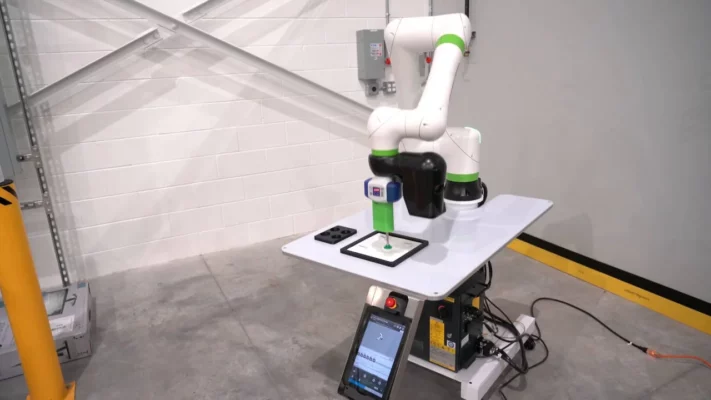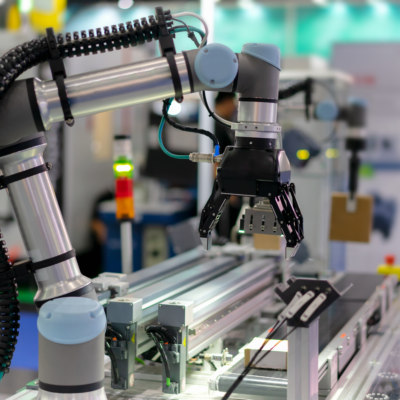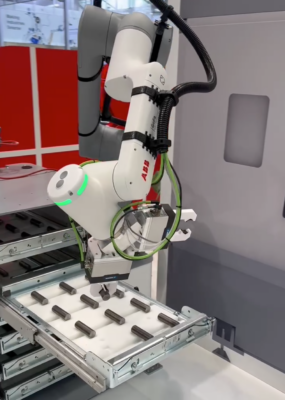Choosing the right cobot for your manufacturing line is crucial. With so many models out there, each with its own set of features, you might wonder where to start. Whether you’re looking to boost packaging efficiency, streamline assembly, or tackle another automation challenge, finding the perfect cobot matters.
This article is here to tell you exactly how you can compare different cobot models.
We’ll walk you through what to look out for, making sure you pick the cobot that meets your specific needs.
Let’s find the ideal cobot for your business together.

Understanding Your Needs:
Before picking a cobot, it’s key to know what you need. Here’s a straightforward way to get started:
What’s Your Goal?
First, think about the tasks you want to automate. Is it packaging, machine tending, or something else? Your goal will guide you to the right cobot.
What Are You Working With?
Look at the items you’ll automate. Different cobots are better for different materials. If you’re handling light boxes or heavy metal parts, your cobot choice will vary.
Check Your Space:
Your workspace matters. How much room do you have? Do you need a cobot that’s good in small spaces or one that can handle tough environments? This will affect your decision.
Can It Fit In?
Make sure the cobot can work with your existing setup. Some cobots are easy to integrate, while others might need extra work.
Safety Is Key:
Safety can’t be overlooked. Choose a cobot that’s safe to work around your team. Look for those with safety features that prevent accidents.
By focusing on these points, you’ll find a cobot that fits your needs perfectly, boosting your efficiency without adding hassle. The right cobot will not just fit in; it will become an essential part of your team’s success.

8 Key Factors to Compare When Selecting Cobots:
When it’s time to choose a cobot, comparing your options is vital. Here’s what to look at to make sure you get the best fit for your needs:
1. Payload Capacity:
This is about how much weight the cobot can handle. Whether you’re moving lightweight items or heavy components, pick a cobot that can lift and carry what you need without breaking a sweat.
2. Reach and Size:
How far does the cobot need to reach, and how much space do you have? Some cobots have long arms for extended reach, while others are compact for tight spaces. Match the cobot’s reach and size to your workspace.
3. Speed and Precision:
Time is money. A faster cobot can increase production, but not at the expense of accuracy. Ensure the cobot you choose strikes the right balance for your tasks.
4. Ease of Programming:
You don’t want to spend all day coding. Look for cobots that are user-friendly, with intuitive programming interfaces. Some even offer drag-and-drop or teach-by-demonstration features.
5. Durability and Maintenance:
Your cobot should be tough enough to handle your environment, whether it’s clean, dusty, or somewhere in between. Also, consider how easy it is to maintain and repair.
6. Integration Flexibility:
It should play well with your existing machinery and software. A cobot that easily integrates saves you time and money on custom solutions.
7. Safety Features:
Cobots are designed to work alongside humans, so safety is crucial. Opt for models with advanced safety functions that can detect and avoid people to prevent accidents.
8. Cost and ROI:
Finally, consider the price and potential return on investment. A more expensive cobot might offer features that speed up production and pay for itself faster.
By keeping these factors in mind, you’ll be well-equipped to choose a cobot that not only meets your immediate needs but also supports your long-term goals. The right cobot will become an invaluable asset to your team, enhancing productivity while ensuring safety and compatibility with your current systems.

Comparing Popular Cobot Models:
When you’re in the market for a cobot, the options can feel overwhelming. Let’s break down a few popular models to help you decide which one might be the best match for your needs:
Universal Robots UR Series:
Known for their versatility, the UR series offers models with different payloads, reaching from 3kg to 30kg. They’re user-friendly, boasting an intuitive programming interface. Perfect for businesses looking for flexibility and ease of integration.
ABB GoFa:
ABB GoFa cobot offers speed, ease of use, and safety for increasing operational efficiency. With a 5kg payload and fast movements, it suits various tasks like machine tending and material handling. Its user-friendly programming makes integration smooth, making GoFa a top choice for boosting productivity.
Fanuc CRX Series:
Fanuc’s cobots are recognized for their strength, offering payloads up to 35kg. They’re durable and designed for heavy-duty tasks. If your operations involve lifting heavier items, a Fanuc CRX might be your go-to.
KUKA LBR iiwa:
The LBR iiwa is celebrated for its sensitivity and precision, featuring state-of-the-art touch sensitivity. This cobot is a fit for tasks requiring delicate handling and fine maneuvering.
Techman Robot:
Techman stands out with its built-in vision system, making it ideal for precise applications like pick-and-place. With payloads up to 14kg and easy programming, Techman cobots are great for operations needing advanced vision capabilities without extra hardware.
Each of these cobots brings something unique to the table. Consider your specific needs—whether it’s payload, precision, ease of use, or integration capabilities. The right cobot can significantly boost your productivity, ensuring your investment pays off by making your operations smoother and more efficient.
Making the Right Choice:
Choosing the right cobot is crucial. It’s not just about getting the newest tech. It’s about what works best for you. Here’s how to make sure you pick wisely:
Know What You Need:
First, figure out the job you need done. Think about the weight of items and how much space you have. This step is key to narrowing down your options.
Future-Proof Your Choice:
Pick a cobot that can grow with your business. You want one that can handle different tasks and is easy to reprogram as your needs change.
Ease of Use is Key:
A hard-to-use cobot can slow things down. Go for one that’s easy to program and operate. This saves time and money on training.
Don’t Skimp on Safety:
Safety is a must. Choose a cobot with solid safety features that can work near your team without risks. Also, check how reliable it is and what it needs for upkeep. You don’t want frequent breakdowns.
Consider All Costs:
Look beyond the price tag. Think about maintenance, upgrades, and how often it might be out of action. A cobot that costs less over time could be a smarter buy.
By focusing on these points, you’ll find a cobot that not only fits your current setup but also boosts your efficiency safely and cost-effectively. The best choice is the one that makes your operations smoother and supports your team’s success.

Conclusion:
Wrapping up, choosing the right cobot is a big deal for your production line. It’s all about understanding your needs, choosing a cobot that can adapt as you grow, finding one that’s easy for your team to use, making sure it’s safe, and thinking about the long-term costs. The right cobot can really boost your productivity and efficiency.
To compare the latest cobot models and find the perfect match for your needs, head over to Qviro.com. We’ve got all the info you need – reviews, side-by-side comparisons, and expert insights. With Qviro, you can pick the best cobot confidently and take your production to the next level.
Do you want to compare different Cobots?






